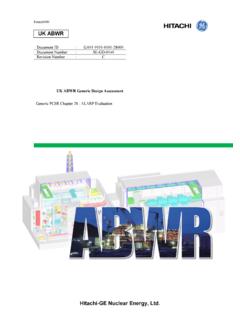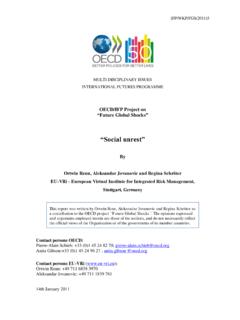Transcription of DECISION MAKING ON APPROVAL OF HIGH …
1 DECISION - MAKING ON ASSESSMENT OF high pressure GAS TRANSMISSION PIPELINES Steve Chatfield HM Principal Inspector of Health and Safety Head of Operational Policy, Gas & Pipelines Unit Hazardous Installations Directorate Health & Safety Executive United Kingdom ABSTRACT In the United Kingdom [UK], the management of pipeline safety is governed by the Pipelines Safety Regulations 19961 [PSR]. These Regulations are goal setting and encompass a risk-based approach to safety. They require pipeline operators to design, build and operate pipelines to ensure that they are safe, so far as is reasonably practicable [SFAIRP].
2 Operators of major accident hazard pipelines, including gas transmission pipelines above 7 bar g, are required to notify the Health and Safety Executive [HSE] before construction, use and significant modification, providing details of the design of the pipeline and operating conditions. This paper discusses HSE s DECISION - MAKING process in determining whether the design and operation of a high pressure gas transmission pipeline complies with PSR and includes HSE s approach to deciding whether risks have been reduced SFAIRP.
3 INTRODUCTION The UK s approach to the regulation of major hazards [which includes hazards from high pressure gas transmission and other pipelines, chemical plants, the nuclear industry and offshore oil & gas industry] has evolved over many years. In a densely populated country like the UK, the government and public want assurance that the risks are being controlled and a safety regime has developed to meet this need. While the detail of the major hazard regimes varies across the different industry sectors, all require duty holders, in one way or another, to demonstrate that the risks are being controlled.
4 HSE has therefore developed a framework to inform its decisions about whether this has been achieved. LEGAL BACKGROUND Health and Safety at Work etc. Act 1974 The principal health and safety legislation in the UK is the Health and Safety at Work etc. Act 1974 [HSW Act]2. It requires risks to employees, and others, to be reduced SFAIRP. Regulations are made under HSW Act to cover a wide range of health and safety risks. HSW Act section 1(2) requires safety standards to be maintained or improved, and when considering options for controlling risk, does not allow for a lowering of safety standards.
5 This principle permeates HSE s approach to the regulation and management of risks. SFAIRP/As Low as reasonably practicable [ALARP] UK legislation uses both terms SRAIRP and ALARP. While it would ultimately be for the Courts to decide, HSE considers that duties to ensure health and safety SFAIRP and duties to reduce risks ALARP call for the same set of tests to be applied. Of particular importance in the interpretation of SFAIRP is the case of Edwards v. The National Coal Board (1949)3. The case established that a computation must be made in which the quantum of risk is placed on one scale and the sacrifice, whether in money, time or trouble, involved in the measures necessary to avert the risk is placed in the other; and that, if it can be shown that there is a gross disproportion between them, the risk being insignificant in relation to the sacrifice, the person upon whom the duty is laid discharges the burden of proving that compliance was not reasonably practicable.
6 HSE expects duty holders to make this gross disproportion test to determine if further risk reduction measures are reasonably practicable. The Pipelines Safety Regulations 1996 [PSR] The Pipelines Safety Regulations 1996 [PSR] were made under the HSW Act and are the principal health and safety legislation in the UK concerning the safety of pipelines. The overall aim is to ensure pipelines are designed and constructed properly and operated safely. The Regulations cover both onshore and offshore pipelines, are goal setting [ they set out the objectives to be achieved but leave freedom on how these objectives are to be met], and allow risk-based approaches that have to satisfy the principles of SFAIRP.
7 PSR covers: Design of the pipeline ; Safety Systems; Construction and installation; Examination and maintenance. Part III of the Regulations define certain pipelines as major accident hazard pipelines [MAHPs]. This includes high pressure gas transmission pipelines conveying gas at pressures > 7 bar g. Operators of MAHPs are required to notify HSE before: Construction; Use; Certain modifications. These notifications provide HSE with the opportunity to assess compliance with PSR. However, the onus remains with the duty holder to justify that their pipelines are safe.
8 HSE has published guidance4 on complying with PSR, which while not law, gives advice on measures available and what is good practice. UK REGULATORY AUTHORITY AND ITS ROLE HSE s Hazardous Installations Directorate is responsible for enforcing PSR. This is carried by: Assessing PSR pipeline notifications; Inspecting pipelines throughout their construction, operation and decommissioning lifecycle; Investigating incidents. Under HSW Act, HSE Inspectors have a range of powers for enforcing PSR. These powers are used in accordance with HSC/E s enforcement policy5 which is based on the following principles: The targeting of action: focusing on the most serious risks or where hazards are less well controlled; Consistency: adopting a similar approach in similar circumstances to achieve similar ends; Proportionality; requiring action that is commensurate to the risks; Transparency: being open on how decisions are arrived at and what are their implications.
9 Accountability: MAKING clear, for all to see, who is accountable when things go wrong. HSE s DECISION MAKING PROCESS Introduction HSE has published a suite of documents concerning its approach to ALARP and SFAIRP judgements. These are designed to give high -level principles that separate parts of HSE can then use to promulgate sector specific guidance. The main documents are: Reducing Risk, Protecting People [R2P2]6; Principles and guidelines to assist HSE in its judgements that duty-holders have reduced risk as low as reasonably practicable7; Assessing compliance with the law in individual cases and the use of good practise8; Policy and guidance on reducing risks as low as reasonably practical in design9.
10 The documents provide the framework under which HSE assesses the safety of pipelines. The framework makes it clear that: Both the level of individual risks and the societal concerns engendered by an activity or process must be taken into account when deciding whether a risk is unacceptable, tolerable or broadly acceptable; The DECISION - MAKING process and criteria adopted are such that action taken is inherently precautionary; HSE starts from the position that, for every hazard, the law requires that: a suitable and sufficient risk assessment must be undertaken to determine the measures needed to ensure that risks from the hazard are adequately controlled; suitable controls must be in place to address all significant hazards; those controls, at a minimum, must achieve the standards of relevant good practice precautions, irrespective of specific risk estimates.












